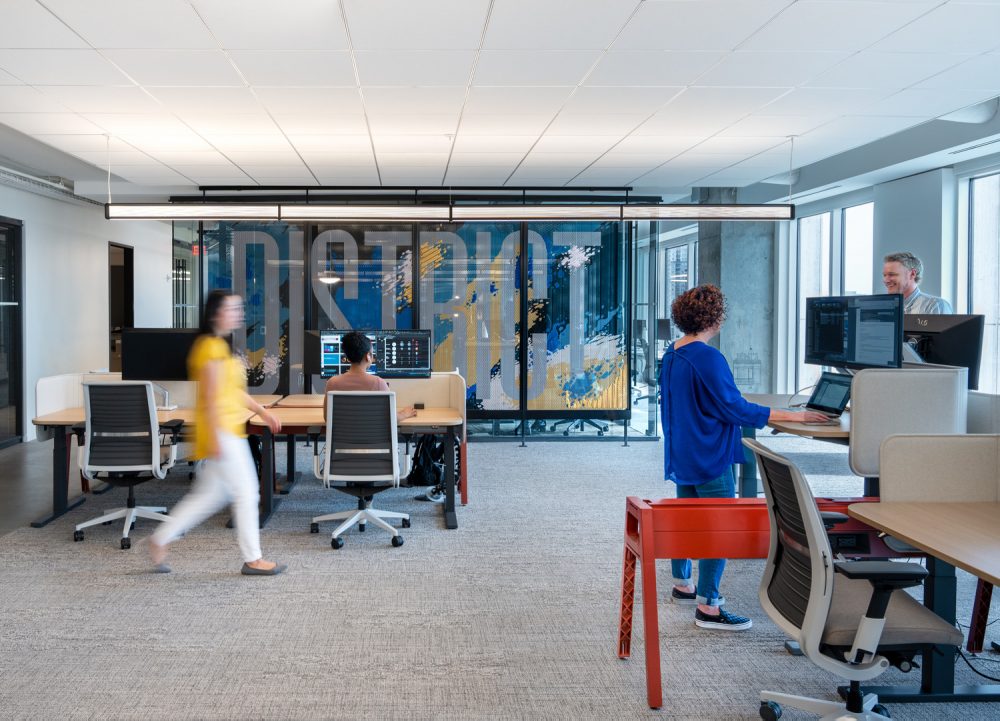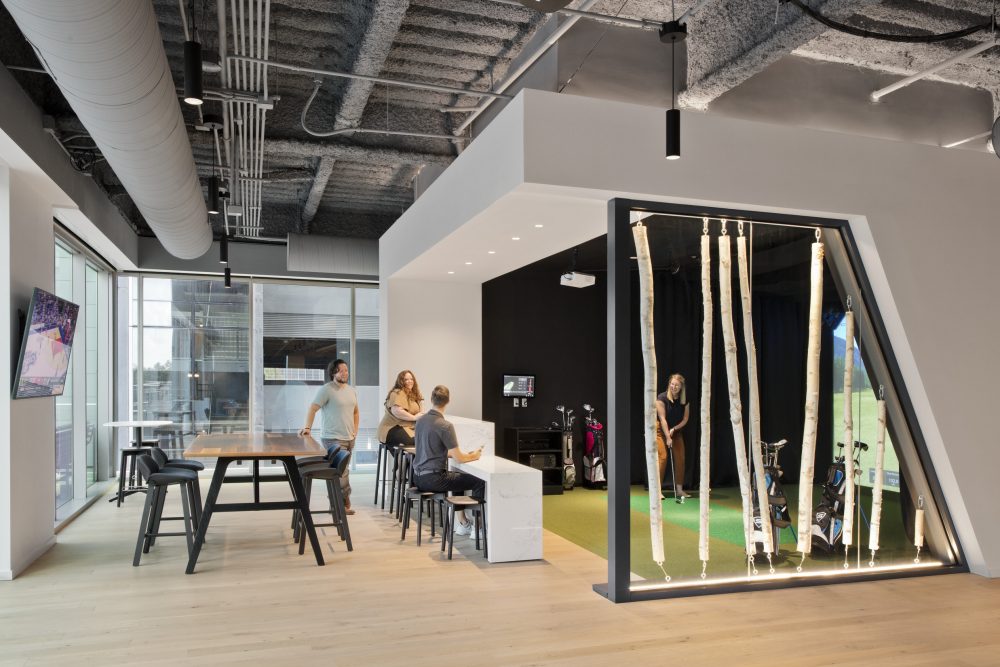SmithGroup’s Kerri McShea tells all on 2025 including what’s staying in 2024, think: AI, gatherings, changing space metrics, bye bye virtual office and more.
In 2024, there was a lot of discussion around RTO and hybrid work. While we believe that these topics will still be relevant in the coming year, we expect the conversation to shift from “attendance” to “performance” and from “what” the office is to “how” the office enables performance. Gone are the days of stagnant offices to purposeful dynamic spaces that spark joy and inspire. Here’s what we expect to be in and out for 2025.
What’s “In” for 2025
AI Empowered Workplaces
AI is quite the buzz right now and we believe there is great potential to incorporate AI into workplaces to enhance the employee experience and to optimize real estate assets. AI can be incorporated to adjust lighting, temperature, and other environmental settings based on individual preferences. In the future, furniture and technology settings may automatically adjust to an individual’s unique settings similar to how many cars do today. Adapting the workplace to the employees, rather than the inverse, will create a frictionless environment that is as comfortable and enjoyable as one’s home office.

Smart scheduling tools can optimize meeting schedules, automate space and desk bookings, and enable social connections. AI tools that can consider an individual’s availability, preferences, and work habits can predict a user’s needs and automatically book their preferred desk or neighborhood as they walk into the building. These smart scheduling tools can also automatically book meeting rooms across locations based on each participant’s location and readjusted based on actual in-office attendance. These tools not only free up time, but also ensure that physical spaces are optimized. And hopefully, these tools could also get more people taking video calls in rooms instead of at desks (more on that later).
Facilitated Gatherings
We all know from data that social connections are critical for purpose, engagement, and relationship building. We also recognize that hoping that these things happen organically is unpredictable. Rather than leave things to chance, many progressive organizations are facilitating onsite gatherings and rituals that bring people together with purpose. Several of these companies have created teams of internal concierges, as well as playbooks to guide teams to plan and facilitate meaningful gatherings. Dropbox is one of these companies. In addition to forming an internal concierge team, they have created a self-service resource, coined “Offsite in a Box,” to make planning and hosting gatherings even easier.1 And the numbers speak volumes, over 70 percent of participants reported that they felt more connected to their team after attending a Dropbox offsite.

The beauty of facilitated gatherings is that they can take place anywhere that can accommodate the desired number of participants, including flexible event spaces within corporate offices (“offsite/onsite”), on-demand co-working spaces, and even residential retreat locations.
SmithGroup’s workplace strategy team is distributed across the country and has embraced this concept with several “strategy summits” planned per year. Each summit takes place at a different SmithGroup office so that participants have an opportunity to connect with other colleagues beyond the strategy team. While the location changes, the purpose does not. Each summit focuses on three main outcomes: team building, collective learning, and future planning. This clear purpose enables the group to accomplish great things when together.
Engagement Scores
With several years of RTO under our collective belt, we are starting to see data that supports the notion that being in the office does not automatically equate to increased productivity. According to a study conducted by Nick Bloom, an economist at Stanford University, productivity was unchanged from working full-time in an office to a hybrid schedule.2 In fact, researchers and companies are finding that engagement has a greater impact on performance than in-person attendance.
 According to Tracy Brower, Vice President of Workplace Insights at Steelcase, engagement is an effective measurement because it drives both satisfaction and productivity. Engaged employees are often aligned with company goals, are highly committed and motivated, and contribute to a positive culture. These traits are commonly shared among high performers. Another important aspect of engagement is connection. As shared at Worktech SF this year by Annica Hoy, Senior Manager of Flex Work & Flex Space at Dolby, Dolby recognizes this and measures the level of connection each employee experiences in its engagement surveys. Connection and engagement will be the metric to measure true performance in 2025.
According to Tracy Brower, Vice President of Workplace Insights at Steelcase, engagement is an effective measurement because it drives both satisfaction and productivity. Engaged employees are often aligned with company goals, are highly committed and motivated, and contribute to a positive culture. These traits are commonly shared among high performers. Another important aspect of engagement is connection. As shared at Worktech SF this year by Annica Hoy, Senior Manager of Flex Work & Flex Space at Dolby, Dolby recognizes this and measures the level of connection each employee experiences in its engagement surveys. Connection and engagement will be the metric to measure true performance in 2025.
What’s “Out” for 2025
Outdated Space Metrics
With flex/hybrid work policies and general dynamics of a modern workplace, the square foot (SF) per person metric is no longer a meaningful metric to plan workplaces or measure utilization, as it is only meaningful when the majority of occupants are onsite together. People are not fixed objects within a space and often times it is difficult to predict how many people will be in a space at once. Rather than focus on SF/person, we anticipate the focus to change to “experienced utilization” where the metric is based on a variety of use cases.
Stagnant Offices
Work has changed drastically in the last four years and so too must the places in which work is done. This is especially true for companies with dynamic or hybrid work models. These models present an opportunity to rethink the new purpose of the office and how it can serve as a tool to realize business objectives and best support teams and individuals. Endless rows of desks will be replaced with dynamic settings that are highly adaptable and support a variety of activities and behaviors that facilitate connection, collaboration, mentorship, and learning. Lauren DeYoung, Allstate’s workplace futurist, said it best in a recent BisNow article, “The days of cubicle farms are over.”

Virtual Office Presence
As companies adapt their workspaces and technology automates room bookings regardless of where people are located, we anticipate an end, or at least a significant decline, to the endless “video calls together” phenomenon that we observe in so many offices. When people join a virtual call from a desk but are physically in the office together, the value of being together has diminished. To realize the benefits of being together, companies should ensure the proper technology and settings are in place, are easy to use, and consistent. In 2025, let’s all agree to break the endless loop of “virtual alone” and embrace the hybrid future together.
All images courtesy of SmithGroup.
Special Thanks to Our 2025 Trends & Predictions Supporter:
![]() Laying the foundation for healthy and productive environments where individuals and teams can do their best work. Explore our 2025 flooring solutions.
Laying the foundation for healthy and productive environments where individuals and teams can do their best work. Explore our 2025 flooring solutions.
Want More Insight from Kerri?
“Exhibiting” a New Approach to Workplace Design

